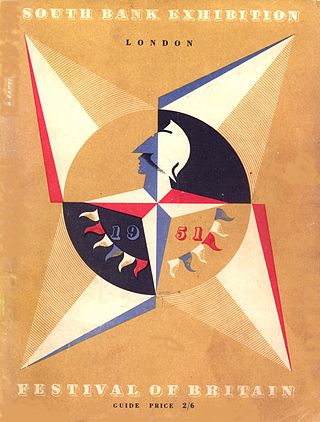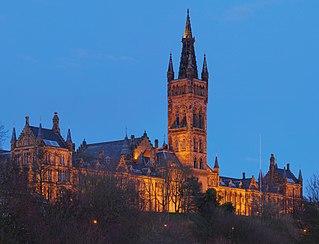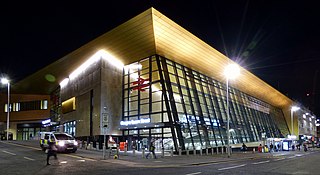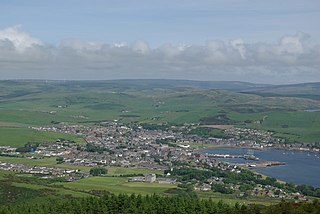
Edinburgh is the capital city of Scotland and one of its 32 council areas. The city was historically part of the county of Midlothian, but was administered separately from the surrounding county from 1482. It is located in Lothian on the southern shore of the Firth of Forth. Edinburgh is Scotland's second-most populous city, after Glasgow, and the seventh-most populous city in the United Kingdom.

The Festival of Britain was a national exhibition and fair that reached millions of visitors throughout the United Kingdom in the summer of 1951. Historian Kenneth O. Morgan says the Festival was a "triumphant success" during which people:
flocked to the South Bank site, to wander around the Dome of Discovery, gaze at the Skylon, and generally enjoy a festival of national celebration. Up and down the land, lesser festivals enlisted much civic and voluntary enthusiasm. A people curbed by years of total war and half-crushed by austerity and gloom, showed that it had not lost the capacity for enjoying itself....Above all, the Festival made a spectacular setting as a showpiece for the inventiveness and genius of British scientists and technologists.

Glasgow is the most populous city in Scotland and the third-most populous city in the United Kingdom, as well as being the 27th largest city by population in Europe. In 2020, it had an estimated metro population of 1,861,315, The city was made a county of itself in 1893, prior to which it had been in the historic county of Lanarkshire. The city now forms the Glasgow City Council area, one of the 32 council areas of Scotland, and is administered by Glasgow City Council. It is situated on the River Clyde in the country's West Central Lowlands.
The Gorbals is an area in the city of Glasgow, Scotland, on the south bank of the River Clyde. By the late 19th century, it had become densely populated; rural migrants and immigrants were attracted by the new industries and employment opportunities of Glasgow. At its peak, during the 1930s, the wider Gorbals district had swollen in population to an estimated 90,000 residents. Along with its relatively small size, this gave the area a very high population density of around 40,000/km2. Redevelopment after WWII has taken many turns, and the area's population is substantially smaller today. The Gorbals was also home to 16 high rise flat blocks; only six are standing as of 2023, and two of them are set to come down in the next couple of years.

Glasgow Queen Street is a passenger railway terminus serving the city centre of Glasgow, Scotland. It is the smaller of the city's two mainline railway terminals and is the third busiest station in Scotland behind Central and Edinburgh Waverley.

Pitlochry is a town in the Perth and Kinross council area of Scotland, lying on the River Tummel. It is historically in the county of Perthshire, and has a population of 2,776, according to the 2011 census.

Campbeltown is a town and former royal burgh in Argyll and Bute, Scotland. It lies by Campbeltown Loch on the Kintyre peninsula. Campbeltown became an important centre for Scotch whisky, and a busy fishing port.

Aberfeldy is a burgh in Perth and Kinross, Scotland, on the River Tay. A small market town, Aberfeldy is located in Highland Perthshire. It was mentioned by Robert Burns in the poem The Birks Of Aberfeldy and in the Ed Sheeran song The Hills of Aberfeldy.

This article is intended to show a timeline of the history of Glasgow, Scotland, up to the present day.

The Citizens Theatre, in what was the Royal Princess's Theatre, is the creation of James Bridie and is based in Glasgow, Scotland as a principal producing theatre. The theatre includes a 500-seat Main Auditorium, and has also included various studio theatres over time.

Govanhill is an area of Glasgow, Scotland, situated south of the River Clyde between Pollokshields, the Gorbals, Strathbungo, Crosshill, Polmadie and Queen's Park. Historically part of Renfrewshire, Govanhill had the status of a police burgh between 1877 and 1891 before becoming part of the City of Glasgow. Since 2007, it has fallen under the Southside Central ward of Glasgow City Council. A previous smaller ward named Govanhill had boundaries of Dixon Avenue and Dixon Road to the south, Victoria Road to the west, Butterbiggins Road to the north and Aikenhead Road to the east.
James Allan Short, OBE, FRSAMD, known professionally as Jimmy Logan, was a Scottish performer, theatrical producer, impresario and director.

The Kelvin Hall, located on Argyle Street in Glasgow, Scotland, is one of the largest exhibition centres in Britain and now a mixed-use arts and sports venue that opened as an exhibition venue in 1927. It has also been used as a concert hall, home to the Kelvin Hall International Sports Arena to 2014, and from 1988 to 2010, Glasgow's Museum of Transport. As part of the economic redevelopment of Greater Glasgow promoted by the Scottish Development Agency and local authorities to enhance the city's tourist infrastructure and to attract further national and international conferences, the Scottish Exhibition and Conference Centre was designed as the Hall's successor for exhibitions and entertainments, built in 1983 and opened on the nearby Queen's Dock in 1985 with an exhibition area equal in size to the Kelvin Hall but with the benefit of extensive car parks and land for other complementary buildings. The Hall is protected as a category B listed building, and is served by city bus services and by Kelvinhall subway station.

The King's Theatre is a theatre in Edinburgh, Scotland.

Janet Horne was the last person to be executed legally for witchcraft in the British Isles.
Ena Lamont Stewart was a Scottish playwright.
Events from the year 1951 in Scotland.
The Gateway Theatre was a Category C listed building in Edinburgh, Scotland, situated on Elm Row at the top of Leith Walk.
Karen Fishwick is a Scottish actor and musician.
Ida Schuster was a Scottish theatre, radio and television actress, theatre director, and a leading figure in Glasgow's 20th-century Jewish theatre community.














